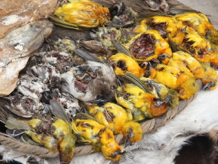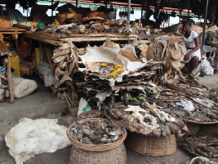From Houston to Sydney 2013

West Africa
2014
The way our day started could not have been more different to the way yesterday ended. We woke this morning to the sound of children and teenagers singing Christian hymns and chanting Christian slogans on a street march outside our hotel. What a contrast to the darkness of last night’s voodoo performance.
Our explorations today began in Abomey at the palace of the last king of independent Dahomey, King Béhanzin (or in Beninese language, Gbêhanzin), also known as “King Shark”, who ruled from 1890 to 1894. Although admired by Beninese people today for withstanding (or delaying_ the French takeover, he does not seem to have been a particularly pleasant person. For example, we were told during our visit that when a mercenary Senegalese commander of the French forces was captured, the king ordered that his arms be cut off, and then after a while his legs be cut off, and then left on the ground to die slowly.
In most ways, the palace today was a less elaborate, less restored and smaller version of the palace museum we saw yesterday, but being a less popular destination, there were slightly more areas where photographs were permitted.
It was originally intended to visit this museum yesterday, but it was closed. Our departure from Abomey at 10:00 am was therefore a little later than the original plan, which would have been to depart at 8:30 am. As things turned out, that was a pity, because the condition of the road was so bad that the journey of 135 kilometres that Google Maps says should take 2 hours and 5 minutes took us more than five hours.
On the first half of the journey (from Abomey to Allada), the sealed road progressively deteriorated with bigger and bigger pot holes until the was no more than a very rough dust track. Some of the pot holes were as large as a car, as we saw when a blue Peugeot disappeared from sight. To add to the challenges, we had to negotiate swarms of ‘France au revoir’ cars swerving all over the road at high speeds trying to avoid pot holes – seeing three cars swerving across the road but heading straight for you at the same time was a bit unnerving at times. And then there were the crashed or broken down trucks that added to the obstacles, in some areas perhaps two or three per kilometre. I managed to get some video footage through the front windscreen of some of the sections of the trip; viewing is not for the faint hearted.
Clearly, some major road works are needed on the road between Bohicon and Allada. Once we passed Allada, there were roadworks – mile after mile after mile of them. Travelling was marginally faster here; it had taken us three hours to drive 74 kilometres to Allada; the next sector of the same distance took us another two hours. Having driven this section of road, I now know why the ‘France au revoir’ cars heading north are all covered in their thick layers of red dust.
Like most (but not quite all) our days of long drives, we had no lunch today. I think that when I bring groups of travellers here, I will suggest they bring some emergency snack rations, or alternatively, we will stop and get some snacks in the morning upon departure. Fortunately today, Mama kindly shared a couple of unripe bananas and some tasty peanuts with us to help with the journey.
At a little after 2:00 pm, we reached the outskirts of Cotonou, Benin’s largest city, its economic capital and its seat of government – but not its capital, which is Porto Novo, to the north-east. The district we entered was known as Abomey-Calavi, and it was the embarkation point for the small pirogue that we would use to take the eight kilometre journey across the waters of Lake Nokoué to Ganvié.
We made our way across an elevated dock that provided us with stunning views of the colourful fish market beside the lake, and boarded our small vessel. We were soon on our way across the water, enjoying an exquisite breeze, travelling past small fishing boats and a few slightly larger pirogues that were serving as ferries. This was quite a quick trip and we were soon entering Ganvie, marketed somewhat optimistically as the “Venice of Benin”.
Ganvié is inhabited by about 30,000 people of the Tofinu tribe who fled the Dahomey slave hunters in the 17th century and built their village on stilts over the water, as religious custom forbade the Dahomey people from venturing into the water. In that sense, Ganvié has remarkably similar beginnings to the stilt villages of the Intha people on Inle Lake in Myanmar, and the appearance of the two areas is also remarkably similar.
The Tofinu people make their living from fishing, which they do by erecting vertical palm branches in the muddy bottom of the shallow lake, and these attract the fish as they start to decompose. I thought the allusion to Venice was somewhat far-fetched (perhaps I should say that the allusion was an illusion), but the town was outrageously picturesque and it was a joy to be there – with just one exception. Although we were encouraged to take photos (but from a distance, no close-ups of people), it was very obvious that many of the people resented photos. Some people lifted clothing to cover their faces, others waved their arms to indicate their displeasure, and in a few cases, children even threw stones and mud at us. Needless to say, this made the visit more uncomfortable than we might have hoped.
By the time we disembarked and returned to the car to complete the drive into Cotonou, it was almost 4:00 pm. Mama suggested that we go to the hotel, check in and have lunch before meeting again to visit Cotonou’s huge market, but Andrew and I immediately agreed that we would prefer to see the market in daylight (i.e. before it closed) and that dinner after the market would be better than a lunch starting at 4:30 pm.
The Grand Marché du Dantokpa (Dantokpa Big Market) is the second biggest market in West Africa; only the market in Kumasi (Ghana) is larger. And huge it is – we walked from end to end, around a bit, back again, up to pedestrian bridge for an overview, down again, and the market was a constant buzz of noise, colour, activity, smells; in short, a microcosm of Beninese commercial life at its best. Photography was difficult for two reasons. First, it was crowded that getting any line of sight was almost impossible. Second, an elevated camera seemed to cause more havoc and alarm than anything imaginable short of an explosion; many (but fortunately not all) people simply did not want their photos taken.
Perhaps the most interesting section of the market, as well as one of the less crowded sections, was the fetish market. This is where followers of voodoo come to get the various components of concoctions that are needed for medicines or casting spells. One of the stall owners was quite friendly and allowed photos of his stall for a small price, and most of the stall are similar. Several did, however, have some remarkable things for sale – I am, for instance, still trying to figure out what disease or spell might require the severed head of a hippopotamus.
The final item on our program for today was a visit to an artisans’ village where, it was promised, we would see local people making handicrafts and works of art. Like the other artisans’ villages we have seen, this one was yet again a collection of shops with persistent (but polite) salesmen; there were no craftsman to be seen anywhere. Having said that, if someone was wanting to buy high quality souvenirs, handicrafts or art from West Africa, this artisans’ centre was probably the best place I have seen so far. The quality was high (but so too, I suspect, were the prices), and the range available was almost breathtaking in its extent.
Andrew and I didn’t linger longer than seemed polite, and we arrived at our hotel at about 6:30 pm. It had been a long day – longer than expected because eof the atrocious road conditions – but the Hotel du Lac more than made up for it. One of the best hotels we have seen on this trip, it overlooks Cotonou Lagoon, the thin body of water than links Lake Nokoué with the Gulf of Guinea.
The restaurant is built on a terrace overlooking the lagoon, and it was a real pleasure to relax there over dinner, enjoying the cool sea breeze. For me, it was the first time I had seen the sea since Monrovia, and it was a welcome sight indeed.

Saturday
18 January 2014
Day 22 - Abomey to Cotonou, Benin






































